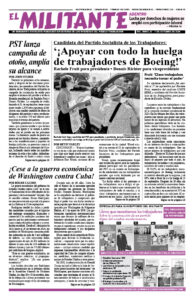Under capitalism all the trappings of government — from the White House to the state houses, the courts of all stripes, and regulatory and other nonelected agencies, to the FBI and cops — serve the interests of the ruling capitalist class, contrary to claims of all bourgeois politicians who say the government acts for “all Americans.”
Their state exists to defend and advance the capitalists’ unending drive to profit off workers’ backs at home, and their imperialist reach for markets and spheres of influence across the world, backed by their bloated war machine. No capitalist class can rule without maintaining a far-reaching political police to spy on, harass and disrupt its opponents — above all those they most deeply fear, the working class and its vanguard fighters.
Today the U.S. rulers are stepping up their use of the FBI and laws like the Foreign Agents Registration Act and other witch hunt statutes. Democrats are at the forefront, targeting Donald Trump and other opponents in capitalist politics and dealing blows to constitutional freedoms.
In 1973, after the Watergate revelations and widespread disillusionment in the government over its murderous war in Vietnam, the leadership of the Socialist Workers Party initiated a political campaign and legal action against the FBI, the U.S. attorney general and other government agencies, challenging decades of spying and attacks on the party. This 15-year victorious fight set an important precedent to be used in the future.
The party won support in the labor movement and beyond, fighting to defend the political space for working people to speak, organize and act — in the factories, on picket lines, in the streets and in politics.
It brought into the open the truth about the government’s use of undercover informers to spy on SWP members, phone bugs and wiretaps, and break-ins and burglaries of party headquarters. The FBI sought to disrupt as much of the party’s work as it could. It got individuals fired from their jobs and evicted from apartments, and fomented factional conflicts between different groups.
The SWP’s fight helped bring to the surface evidence of similar disruption operations against militants fighting to bring down Jim Crow segregation, organizers of solidarity with Cuba’s socialist revolution, emerging leaders of the fight for women’s emancipation and opponents of Washington’s wars.
During the trial of the SWP’s case against the FBI, the government attempted to justify its Cointelpro operations with accusations that the SWP was conspiring and covering up its real revolutionary aims. But the trial showed the opposite was true. The SWP made no secret that its goal was to lead the working people to take political power, explaining its revolutionary views were protected by the Constitution.
It was the government and their snoops that concealed their methods, aims and assault on key rights all workers need.
The party’s campaign led to a groundbreaking victory in 1986. Judge Thomas Griesa ruled there was no evidence “that any FBI informant ever reported an instance of planned or actual espionage, violence, [or] terrorism by the party or its members.” He ruled that the use of the FBI to infiltrate organizations and spy on individuals engaged in political activity, including communists and other working-class fighters, violated the Constitution.
The rulers are taking steps today to refurbish the FBI and resurrect espionage and other frame-up laws. The SWP ruling still stands, an example and a tool for working-class fighters to use.

